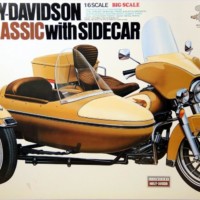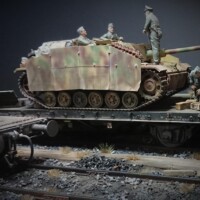Operation Gisela
I built this kit way back in 2009. Having seen Rafi's (@blackmopane) recent posting of his Ju 88G-6, I decided to take some new photos of mine and post them here.
Subject
This model represents the night fighter flown by the commander of 7/NJG 2, Oblt. Walter Briegleb and his crew, radio operator Uffz. Brandt, radar operator Fw. Weilbaucher and mechanic Uffz. Braunlich. Briegleb claimed 26 kills at night, the last two which were Lancaster bombers scored during 'Unternehmen Gisela' (Operation Gisela).
On the night of the 3rd/4th of March, 1945, Unternehmen Gisela saw around 80 Ju 88Gs from I, II, and III/NJG 2, III and IV/NJG 3, III/NJG 4 and III/NJG 5 set off towards England in order to intercept RAF Lancasters and Halifaxes as they returned from two separate raids over Germany. The night fighters flew low over the North Sea at under 100m in order to avoid being detected by British radars. They also flew without their radar or radio altimeters on to avoid their emissions be detected and alerting Allied night fighters. Once over the UK they headed for RAF airfields, still with their radars off, and scoured the night sky for bomber navigation lights. The night fighters also carried bombs that they dropped over airfields or cities as the opportunity presented itself.
Of the 456 RAF bombers that flew that night, 33 were lost. 24 of these were claimed over the UK by the returning Ju 88G crews and at least 7 were downed over Germany, two of these being victims of the top Nachtjagd Experte, Major Heinz-Wolfgang Schnaufer. The remaining two bombers possibly being the victims of Nachtjagd crew that did not return from the night's mission.
In exchange for the 24 bombers claimed by Unternehmen Gisela, the Nachtjagd lost 33 Ju 88s: 5 shot down over the UK, 8 missing, 3 crashed on German territory, 6 abandoned by their crew due to lack of fuel and 8 crashed on landing, with the fate of the remaining 3 being uncertain.
Two more operations were carried out in March, but on a much smaller scale and with little effect.
Construction
Construction was fairly straight forward although the fit of the wingtips to the wings is a known problem with these kits, the solution for which is to attach the upper wing tip to the upper wing and lower wing tip to the lower wing and then join upper and lower halves.
The second fit issue is the forward fuselage, which contains the cockpit, to the rest of the fuselage. This was designed this way to allow for both bomber and fighter cockpits, as well as the Ju 188 cockpit and Mistel warhead. The issue here is that the forward fuselage includes the leading edge of the wing root fairing that needs to be blended with the aft part of the fairing.
The cockpit itself is nicely detailed but, curiously, while the kit includes etched metal parts, it doesn't include seat belts. So, I added these using an Eduard set.
The rest of the build was as per the instructions.
Colours and Markings
I decided to tackle painting this aircraft in stages to replicate the manner in which the original was painted. The aircraft would have been painted RLM 75 Grey-Violet (Gunze Sangyo H69 plus a dash of Red) top sides and Gunze Sangyo H417 RLM 76 Light Blue below at the time of manufacture. Then the RLM 75 was over-sprayed in a revers mottle process where the RLM 76 was sprayed leaving patches of the underlying RLM 75. This may have been done at component level because there are photos of aircraft with two tone fuselage, tail, ailerons, flaps and engines but with RLM 75 wings.
Also, the style of mottling typically differed for the various components with often small mottles with sharp edges on the fuselage and small less distinct mottles on the vertical and horizontal tail surfaces and engines. The flaps and ailerons could be either small or large mottles while the wings seemed to have larger, less distinct mottles.
To achieve this, I painted the aircraft RLM 76 below and RLM 75 on top with a sharp demarcation line, which is evident in photos, particularly for this aircraft. I then used small balls of Blu-tack as masks on the fuselage to create the sharp-edged mottle when I sprayed the RLM 76 over the RLM 75. I then tried to free-hand the RLM 76 over-spray on the rest of the aircraft but couldn't get a satisfactory effect. It is harder to reverse mottle than you would think. So, I sprayed the rest of the aircraft RLM 76 and then added more conventional RLM 75 mottles.
The flaps and ailerons were masked off and painted separately to the wing in order to ensure that the mottling looked like they were painted independently and did not cross between wing and control surfaces. The tail surfaces and control surfaces were painted with smaller free hand mottles as if they were painted when assembled. Engines were likewise masked off from the wing and painted with small freehand mottles.
That resulted in an interesting variety of paint styles across the aircraft for the underlying camouflage. At this time the national insignia, serial number and squadron codes were added and it is likely that the aircraft flew operations with this scheme. So, I added the relevant decals at this point.
While the aircraft probably operated for a time with this scheme, at a later stage the aircraft was further over-sprayed with RLM 82 (Gunze Sangyo H422 Light Green) and RLM 83 (Gunze Sangyo H423 Dark Green) in order to darken the camouflage for ground concealment, with the camouflage coming further down the fuselage and engine nacelle sides. This was probably in response to the marauding allied fighters that were strafing everything they could find.
It is evident from the photos of the aircraft that the new camouflage also partly over-sprayed and obscured the serial number on the fin so I copied this when I sprayed the two greens. I temporarily masked the other markings with post-it notes to avoid unnecessary over-spray. From the photo it also seems that the victory markings were applied after this over-spray was applied to the aircraft, so I did that as well.
The propellers and spinners were painted RLM 70 (Gunze Sangyo H65 RLM 70) and the exhausts painted black with a brushing of rust.
A mix of black, grey and brown was used for exhaust streaks which could be very heavy along the nacelles under the wings while less so on the tailplane.
Conclusion
Although there are some fit issues with the wing tips and cockpit t o fuselage join, these can be dealt with. I particularly enjoyed painting the complex camouflage and the end result is a satisfying build.


















Awesome
G'day George (@blackadder57),
That was a record response, I've only just posted.
Thanks for looking.
That's a fantastic Ju88, Michael @michaelt
Especially the camouflage is amazing, this has likely taken you quite some time to get it done this nicely.
The paintwork is incredible, @michaelt. Just superb work and a great result.
What Tom said - awesome paintwork!
Excellent model and superb paint job, Michael!
G’day Spiros (@fiveten), John (@johnb), Tom (@tcinla) and Chas (@chasbunch),
Thanks for your kind comments.
I think I’m a better painter than I am builder.
I really enjoy researching and painting complex schemes, paying attention to replicating what I see in photos, when available.
On my more recent builds I’ve been trying to improve my weathering, which is a bit limited on this build.
We all strive to learn from others and improve our skills.
Superb results specially painting is unbelieveble !
Bravissimo
G'day Tarantino (@tarantinopaolo),
Thanks for your kind comment.
Great looking 88. I really like the camo scheme.
G’day Dale (@dtravis),
Thanks for your kind comment.
Yep - love the paintwork on this one! Excellent build.
G’day Greg (@gkittinger),
Thanks for your kind comment.
Hey mate - that's a very intricate paint job there - very impressed. Well done
G’day Scott (@scottiya),
Thanks mate.